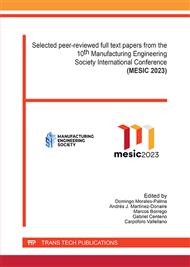[1]
Djassemi, M., and Sena, J. A. (2006). "The paperless Factory: A review of issues and technologies." International Journal of Computer Science and Network Security, 6(12), 185.
Google Scholar
[2]
Hawley, J., and Mackowiak, B. (1991). "Paperless assembly using touchscreen based graphics." Eleventh IEEE/CHMT IEMT Symposium, pp.231-234, IEEE.
DOI: 10.1109/iemt.1991.279784
Google Scholar
[3]
Price, Tom, et al. (2012). "Paperless Track Inspection Record Keeping and Compliance." Rail Transportation Division Conference. Vol. 45073. American Society of Mechanical Engineers.
DOI: 10.1115/rtdf2012-9432
Google Scholar
[4]
Zakoldaev, D. A., A. V. Shukalov, and I. O. Zharinov. (2019). "From Industry 3.0 to Industry 4.0: production modernization and creation of innovative digital companies." IOP conference series: Materials Science and Engineering. Vol. 560. No. 1. IOP Publishing.
DOI: 10.1088/1757-899x/560/1/012206
Google Scholar
[5]
Helmke, H., et al. (2017). "Increasing atm efficiency with assistant based speech recognition." Proc. of the 13th USA/Europe Air Traffic Management Research and Development Seminar.
Google Scholar
[6]
Beato, B., et al. (2011). "Going paperless: implementing an electronic laboratory notebook in a bioanalytical laboratory." Bioanalysis, 3(13), 1457-1470.
DOI: 10.4155/bio.11.117
Google Scholar
[7]
Zinchenko, K., Wu, C. Y., and Song, K. T. (2016). "A study on speech recognition control for a surgical robot." IEEE Transactions on Industrial Informatics, 13(2), 607-615.
DOI: 10.1109/tii.2016.2625818
Google Scholar
[8]
Elazzazi, M., Jawad, L., Hilfi, M., and Pandya, A. (2022). "A Natural Language Interface for an Autonomous Camera Control System on the da Vinci Surgical Robot." Robotics 2022, 11, 40.
DOI: 10.3390/robotics11020040
Google Scholar
[9]
Pocketsphinx repository from CMU Sphinx.https://github.com/cmusphinx/pocketsphinx. Last Access: 2023-01-16.
Google Scholar
[10]
Manasa, C. S., Priya, K. J., and Gupta, D. (2019). "Comparison of acoustical models of GMMHMM based for speech recognition in Hindi using PocketSphinx." 3rd International Conference on Computing Methodologies and Communication (ICCMC), pp.534-539. IEEE.
DOI: 10.1109/iccmc.2019.8819747
Google Scholar
[11]
Povey, D., et al. (2011). "The Kaldi speech recognition toolkit." IEEE 2011 workshop on automatic speech recognition and understanding (No. CONF). IEEE Signal Processing Society.
DOI: 10.1109/asru.2011.6163923
Google Scholar
[12]
Hannun, Awni, et al. (2014). "Deep speech: Scaling up end-to-end speech recognition." arXiv preprint arXiv:1412.5567.
Google Scholar
[13]
Mozilla Common Voice Dataset. https://commonvoice.mozilla.org/en. Last Access: 2023-01- 16.
Google Scholar
[14]
Vosk Website. https://alphacephei.com/vosk/. Last Access: 2023-01-16.[15] Radford, A., et al. (2022). "Robust speech recognition via large-scale weak supervision." arXiv preprint arXiv:2212.04356.
Google Scholar
[16]
Errattahi, R., Hannani, A.E., and Ouahmane, H. (2015). "Automatic Speech Recognition Errors Detection and Correction: A Review." International Conference on Natural Language and Speech Processing.
DOI: 10.1016/j.procs.2018.03.005
Google Scholar
[17]
McCowan, I.A., Moore, D., Dines, J., Gatica-Perez, D., Flynn, M., Wellner, P., Bourlard, H. (2004). "On the use of information retrieval measures for speech recognition evaluation." Technical Report. IDIAP.
Google Scholar
[18]
Mostefa, D., Hamon, O., and Choukri, K. (2006). "Evaluation of Automatic Speech Recognition and Speech Language Translation within TC-STAR: Results from the first evaluation campaign." LREC, pp.149-154.
Google Scholar
[19]
JiWER: Similarity measures for automatic speech recognition evaluation. https://github.com/jitsi/jiwer. Last access: 2023-01-16.
Google Scholar



